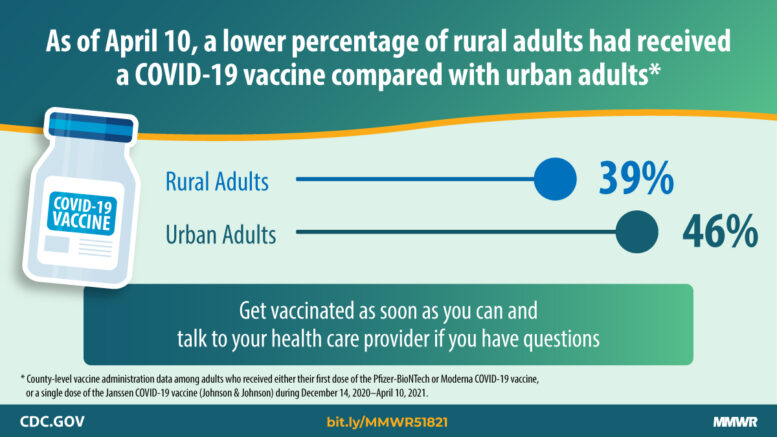To better understand COVID-19 vaccination disparities across the urban-rural continuum, researchers at the CDC analyzed county-level vaccine administration data among adults aged ≥18 years who received their first dose of either the Pfizer-BioNTech or Moderna COVID-19 vaccine, or a single dose of the Janssen COVID-19 vaccine (Johnson & Johnson) during December 14, 2020–April 10, 2021 in 50 U.S. jurisdictions (49 states and the District of Columbia).
According to Murthy, et al. (2021), adult COVID-19 vaccination coverage was lower in rural counties (38.9%) than in urban counties (45.7%) overall and among adults aged 18–64 years (29.1% rural, 37.7% urban), those aged ≥65 years (67.6% rural, 76.1% urban), women (41.7% rural, 48.4% urban), and men (35.3% rural, 41.9% urban). Vaccination coverage varied among jurisdictions: 36 jurisdictions had higher coverage in urban counties, five had higher coverage in rural counties, and five had similar coverage (i.e., within 1%) in urban and rural counties; in four jurisdictions with no rural counties, the urban-rural comparison could not be assessed. A larger proportion of persons in the most rural counties (14.6%) traveled for vaccination to nonadjacent counties (i.e., farther from their county of residence) compared with persons in the
To read more from the Morbidity and Mortality Weekly Report, CLICK HERE.
Reference: Murthy BP, Sterrett N, et al. Disparities in COVID-19 Vaccination Coverage Between Urban and Rural Counties — United States, December 14, 2020–April 10, 2021. Morbidity and Mortality Weekly Report. Vol. 70. May 18, 2021.

Be the first to comment on "Researchers Report on Disparities in COVID-19 Vaccination Coverage Between Urban and Rural Counties"